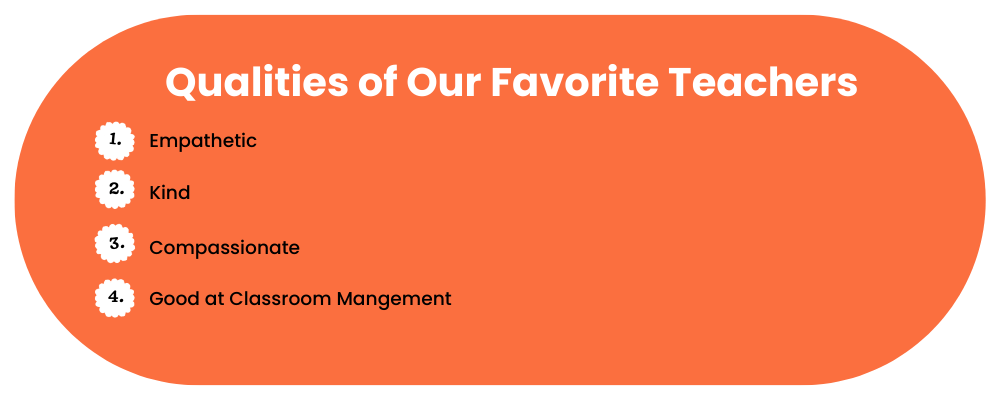Do you remember the teacher who inspired you to become a teacher? What was that teacher and student relationship like?
When we polled our team of veteran teachers about their own favorites from childhood, we noticed a lot of the same descriptions kept coming up:

That last one may sound like it doesn’t belong, at least not at first. When you think empathetic and kind, you’re probably thinking sweet Miss Honey from Matilda or Mr. Slinger from Kevin Henkes’ classic Lilly’s Plastic Purse. These children’s book characters will go down in history for doing the most to encourage their students to be their best, unique selves.
But here’s something they don’t teach you in college: Making those unforgettable connections with your students is the key to a classroom management plan that will really work. It’s also a cornerstone of engaging your students in learning.
Maybe you’ve heard the saying “students don’t care what you know until they know you care?” While it’s true, putting in time, providing feedback and connecting on a human level will get you to a point where you can reach — and teach — your students.
The big question we can already feel coming is: “OK, but HOW?”
There’s no magic button that will connect you to your students, but there are some methods that the teachers on Teach Starter’s team have developed over the years in the classroom to build rapport and make students feel valued.
Teacher and Student Relationship Building Tips
Here are some of our teacher team’s favorite ways to build a solid teacher-student relationship.
Explore the whole list, but please remind yourself that these are suggestions and not requirements. Some may work for your classroom, and some may not. Select the methods that work best for you and your students!
- Greet your students at the door each day. You’ll be able to tell by their demeanor who is having a good day and who may be struggling. Hang a greetings option poster near your classroom door, and allow them to choose how to greet you — a fist bump, a high five, a wave?
- Set up a lunch bunch. Once a week, invite 4 or 5 kids (change it up each week) to eat lunch in the classroom with you. Your lunchtime is valuable, so we don’t expect you to give it up all the time! But this time with small groups can help break down barriers.
- Attend student events. If you can attend just one dance recital or a football game, your students will not forget it!
- Keep inclusion front of mind. From how you celebrate classroom holidays to buying books for your classroom library, keep inclusivity in mind. When children see themselves represented in every facet of your teaching, they feel it, and they remember it.
- Start the school year off with letter writing. Many teachers love to write a meet-the-teacher letter when school begins, but asking students to write back can help you in two ways. Not only do you get to sense-check their writing skills from the word go, but you also learn so much about your students that you can use to build that student-teacher relationship.
- Use “help” time wisely. When students call you over for one-on-one help, don’t jump right into the problem. Ask how their day is going. It won’t take much time, but it is a great way to open the doors of communication.
- Communicate the “why” behind rules and procedures. As adults, we wouldn’t want to be told to do something without an explanation, and the same applies to our students. As you craft your classroom rules, getting student buy-in and clearly explaining the reason the rules exist in the first place will make students feel more valued.
- Show your vulnerability. Did you just make an oops on the whiteboard? Do you feel that you didn’t explain that concept as well as you meant to? Modeling how we react when we make mistakes is a crucial piece of helping students build their own social skills, and this can go a long way toward cementing a good teacher-student relationship.
- Ask students for photos of their pets. This tip from a teacher on our team gets four paws up: Ask students for photos of their pets, and use them throughout the year as “art” in your teaching slides for that personal touch. Your students will love it!
- Add a morning check-in to your routine. It doesn’t have to be big! Your check-in could be as simple as asking “How are you feeling?” and having students put their thumb up for “having a good day,” thumb down for “not so good,” or thumb sideways for “I’m not sure yet.” This will help you see who might need a little extra love throughout the school day.
- Ask students to share their pet names or hobbies at the beginning of the year. Incorporate them into your math word problems throughout the term for a surprise that will elicit big smiles.
- Add a “just for me” note box to your desk. Sometimes students struggle to share their worries face-to-face. Adding a ‘Just for Me’ box on your desk where students can leave notes that only you will read can open up those important lines of communication without the stress of having to say things out loud.
A Final Reminder
There will be students who are harder to reach than others, and you may find that not every student lists you as their favorite teacher. That’s OK. With every student, keep the traits of the teachers you most admire in mind:
- Empathy
- Kindness
- Compassion
The classroom management will follow!
Explore our teacher team’s favorite teacher-student relationship resources to help
build your own safe and encouraging learning environment.
Banner image via Shutterstock/Rawpixel.com








Comments